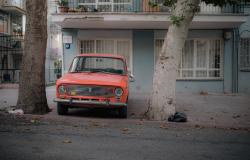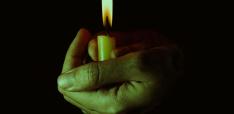Pro-Putin movement expands across the former Soviet bloc – here’s why

Stefan Wolff argues that Europe's problems are deeper than who wins or loses in Ukraine.
As Russia keeps pounding Ukrainian cities with airstrikes and advances along the frontline in Donbas, regional elections in two states in eastern Germany have seen a surge of support for parties on the extreme right and extreme left.
What is particularly concerning is that both parties oppose support for Ukraine and back a more Kremlin-aligned view of the Russian aggression against Ukraine. They put most of the blame on the west for provoking Russia and tap into a reservoir of fear of being dragged into a full-blown military confrontation with Moscow.
Such views, and their success at the ballot box, are not unique to the former East Germany. Other states in central and eastern Europe that were under Soviet control until 1989 have seen the rise of similar sentiments, most notably among them EU and Nato members Slovakia and Hungary.
The same is true for some states that were formerly part of the Soviet Union, such as Azerbaijan and Georgia. Representing a curious mix of fear, resentment and nostalgia, this does not mean the restoration of the Soviet bloc by stealth, but it points to an ideological consolidation in at least part of that region.
In Hungary, this pro-Russian position is predominantly associated with the country’s populist prime minister Viktor Orbán. In power since 2010, Orbán has moved himself, and his country, away from the liberal democratic ideals that he espoused in the late 1980s and early 1990s.
This has led to the European Commission and parliament condemning Orbán for undermining democracy and the rule of law.
The European Court of Justice has imposed a €200 million (£168 million) fine on Hungary for deliberately infringing EU asylum rules. None of that stopped Orbán from a fourth consecutive victory in national elections in 2022, but it pushed his alliance to below 50% of the vote in European parliament elections in 2024.
Despite securing less than half of the vote in European elections for the first time in two decades, Orbán doubled down on his pro-Putin stance. He was the first prime minister of any EU and Nato member to shake hands with Putin. In October 2023 in Beijing, he repeated the same stunt in Moscow just days after Hungary assumed the EU’s rotating presidency in July 2024.
His Slovak counterpart, Robert Fico, regained his country’s premiership in October 2023, also on a more pro-Russian and anti-Ukrainian platform.
In contrast to Orbán, Fico is a left-wing populist and has moderated his stance on Ukraine following a visit to Kyiv in January 2024. Yet the broader pro-Russian sentiment among most of the electorate was evident in the presidential elections in April 2024.
Outside Nato and the EU, other leaders have also cosied up to Putin. One example is Azerbaijan’s long-serving ruler, Ilham Aliyev, who visited Moscow in April 2024 and welcomed Putin to Baku in August.
Since the start of the war against Ukraine in February 2022, Azerbaijan has been pivotal to Russia, providing access to essential trade corridors, to circumvent western sanctions. One of these is the international north-south transport corridor which links Russia through Azerbaijan to Iran.
Azerbaijan also submitted its official application to join the Brics alliance (Brazil, Russia, India, China and South Africa) a day after Putin’s visit in August. It also applied, at the end of July, for observer status in the Shanghai Cooperation Organisation, bringing Azerbaijan one step closer to full membership in the Chinese-led bloc.
And then there is Georgia – once a beacon of democratic renewal in the post-Soviet space and now gradually sliding into pro-Russian autocracy. Tbilisi and Moscow have gradually rekindled ties under the Georgian Dream political party, which has ruled the country for more than a decade, despite the 2008 Russian-Georgian war.
Protests in Georgia.
Rhetorically, the Georgian government remains committed to EU membership. A European Council decision of December 2023 granted Georgia candidate-country status. Yet relations with the EU have soured significantly since the spring when the government in Tbilisi rammed through the so-called foreign agents law, despite public and EU protests.
The law presents a potentially useful tool for Georgia’s government to constrain the work of pro-European civil society organisations, and is modelled on recently expanded Russian legislation.
Authoritarian drift
The fact that more than two and a half years into a brutal war, Russia as the aggressor country enjoys a kind of resurgence in sympathy must clearly be worrying for Ukraine and its western partners. The increasing authoritarian drift in eastern Germany, Slovakia and Hungary, and Azerbaijan and Georgia did not start with the war in Ukraine but has undoubtedly accelerated as a result.
The political leaders driving it capitalise on, and carefully channel, different public sentiments. One of these is a long-standing fear of being dragged into a war with Russia, another is the resentment of a self-serving political establishment that has mismanaged the fallout from COVID and the cost-of-living crisis triggered by the war in Ukraine.
There is also, at least for some, a degree of nostalgia for an imagined Soviet bloc past and the “order” that strong and essentially socially conservative leaders at the time imposed, compared with the liberal “chaos” that has ensued since.
Last year’s presidential elections in the Czech Republic and parliamentary elections in Poland demonstrate that the kind of democratic backsliding seen elsewhere in the former Soviet bloc can be halted and reversed. Similarly, Armenia’s decision to pull out of the Russia-led Collective Security Treaty Organisation — a mini post-Soviet Warsaw pact successor — indicates that geopolitical alignments are not set in stone.
All these changes are signs of an unsettled European and global security order. When and how the war in Ukraine ends will determine what kind of new order is likely to settle in. The simultaneous rise in right- and left-wing populism, and of older and newer autocracies and their ideological alignment with the Kremlin, however, sends a note of extreme caution that the reconstitution of a new liberal order is far from certain — regardless of who, if anyone, wins in Ukraine.![]()
Stefan Wolff, Professor of International Security, University of Birmingham.
This article is republished from The Conversation under a Creative Commons license. Read the original article.
Photo by Burak Berkay


